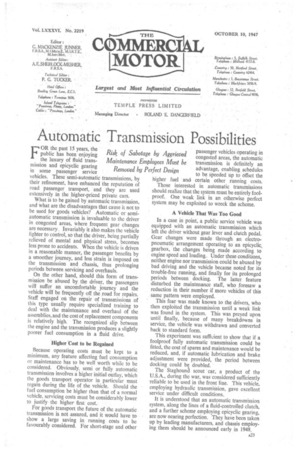Automatic Transmission Possibilities
Page 25

If you've noticed an error in this article please click here to report it so we can fix it.
FOR the past 15 years, the public has been enjoying Risk of Sabotage by Aggrieved the luxury of fluid transMaintenance Employees Must be mission and epicyclie gearing Removed by Perfect Design in some passenger service in some passenger service vehicles. These semi-autoniatic transmissions, by their refinement, have enhanced the reputation of road passenger transport, and they are used extensively in the higher-priced private cars.
What is to be gained by automatic transmission, and what are the disadvantages that cause it not to be used for goods vehicles? Automatic or semiautomatic transmission is invaluable to the driver in congested areas, where frequent gear changes are necessary, Invariably it also makes the vehicle lighter to control, so that the driver, being partially relieved of mental and physical stress, becomes less prone to accidents. When the vehicle is driven in a reasonable manner, the passenger benefits by a smoother journey, and less strain is imposed on the transmission and chassis, thus prolonging periods between servicing and overhauls.
On the other hand, should this form of transmission be abused by the driver, the passengers will suffer an uncomfortable journey and the vehicle will be frequently off the road for repairs. Staff engaged on the repair of transmissions of this type usually require specialized training to deal with the maintenance and overhaul of the assemblies, and the cost of replacement components is relatively high. The recognized slip between the engine and the transmission produces a slightly poorer fuel consumption in a fluid drive.
Higher 'Cost to be Regained Because operating costs must be kept to a minimum, any feature affecting fuel consumption or maintenance has to be well worth while to be considered. Obviously, semi or fully automatic transmission involves a higher initial outlay, which the goods transport operator in particular must regain during the life of the vehicle. Should the fuel consumption be higher than that of a normal vehicle, servicing costs must be considerably lower to justify the higher first cost.
For goods transport the future of the automatic transmission is not assured, and it would have to show a large saving in running costs to be favourably considered. For short-stage and other passenger vehicles operating in congested areas, the automatic transmission is definitely an advantage, enabling schedules to be speeded up to offset the higher fuel and certain other running costs.
Those interested in automatic transmissions should realize that the system must be entirely foolproof. One weak link in an otherwise perfect system may be exploited to wreck the scheme.
A Vehicle That Was Too Good In a case in point, a public service vehicle was equipped with an automatic transmission which left the driver without gear lever and clutch pedal. Gear changes were made through an electropneumatic arrangement operating to an epicyclici, gearbox, the changes being made according to engine speed and loading. Under these conditions, neither engine nor transmission could be abused by bad driving and the vehicle became noted for its trouble-free running,, and finally for its prolonged periods between docking. The latter feature disturbed the maintenance staff, who foresaw a reduction in their number if more vehicles of this same pattern were employed.
This fear was made known to the drivers, who then exploited the transmission until a weak link was found in the system. This was preyed upon until finally, because of many breakdowns in service, the vehicle was withdrawn and converted back to standard form.
This experiment was suffi...ient to show that if a foolproof fully automatic transmission could be fitted, the cost of spares and maintenance would be reduced, and, if automatic lubrication and brake adjustment were provided, the period between docking could be doubled. The Staghouna scout car, a product of the U.S.A., during the war, was considered sufficiently °reliable to be used in the front line. This vehicle, employing hydraulic transmission, gave excellent service under difficult conditions.
It is understood that an automatic transmission system, along the lines of a fluid-controlled clutch, and a further scheme employing epicyclic gearing, are now nearing perfection. They have been taken up by leading manufacturers, and chassis employing them should be announced early in 1948.




















































































